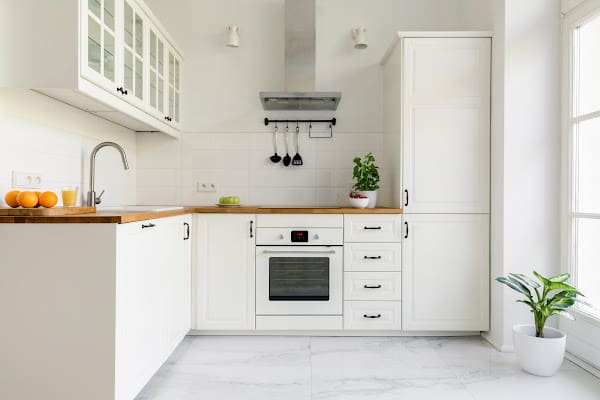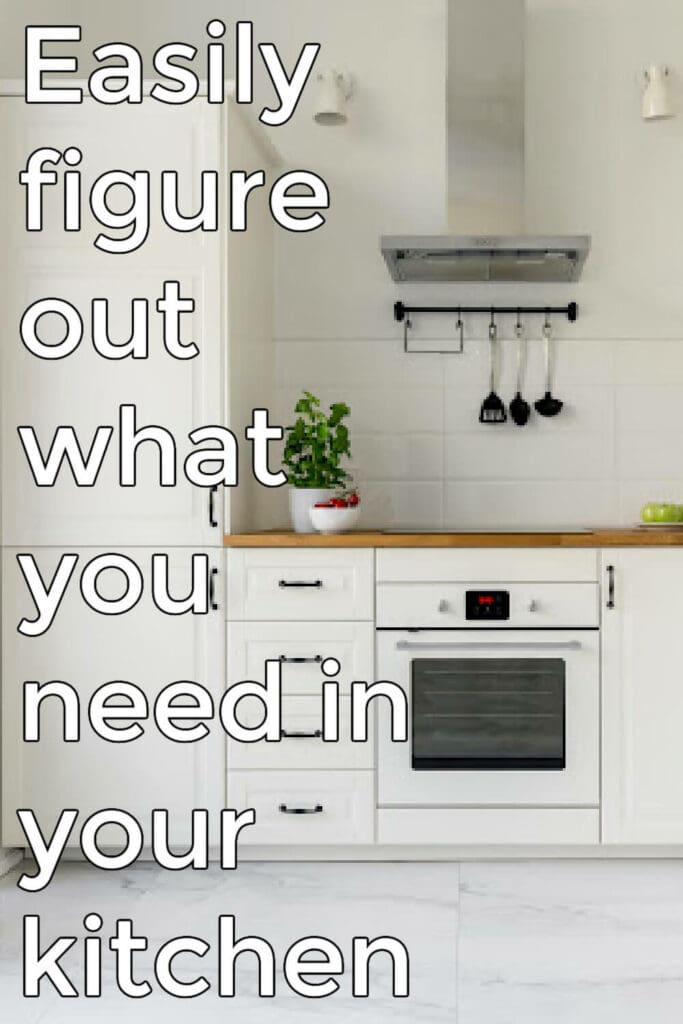Questions to ask to help figure out what you need in your kitchen

When I was first decluttering, I wanted a list of exactly what I should have:
- How many place settings?
- How many mixing bowls?
- Do I need 2 rubber scrapers?
- What about pots and pans? 2-quart, 5-quart? What’s the best?
Unfortunately, I can’t give you an exact list of what you should keep in your kitchen because my cooking habits are going to look completely different than yours:
I cook twice a day for five people and make a wide variety of foods, from crepes and focaccia to curries and spaghetti.
And frequently cook for large crowds of 20+, so I have several very large pots and pans.
So my needs will look very different from a retired couple who enjoy more premade items.
But there are a few ways we can approach our kitchen to determine what we need.
If you’re a journaler, ask yourself these questions so you have a better idea of your needs:
- How many meals a day do I cook?
- How many people do I cook for each meal?
- Do I entertain?
- If yes, how many, how often, etc.?
- And what do I normally serve during these times?
- What types of foods do I cook most of the time? (prepared, frozen, grilled, from scratch, baked goods, etc.)
If you take a little time to write down your honest answers (not the fantasy-self answers), you can better gauge what you need.
If you have four people that regularly eat at home, a table setting for 4-6 people is all that is needed.
If you entertain frequently, figure out what that means to you. For some people, that means pizza and movie night with three extra people. For others, that means a group of 20 for a potluck every Saturday night.
It’s really just about being honest with ourselves about how we live our lives.
There is no need to hold onto wine glasses if everyone in your group drinks coffee. And there is no need to have place settings for 20 when you only have two people eating a meal.
If you’d rather do an experiment to find out what tools you depend on, here is how to do that:
Two ways to figure out EXACTLY what tools you need:
- Box everything up, put it in another room, and for the next two weeks, “shop” what you need as you cook. By the end of 2 weeks, everything you use regularly will be in the kitchen, and all the “fluff” will be in boxes still. Or…
- Keep a list for two weeks of everything you use as you work in your kitchen. When you cook, write down all the tools you use. If you use a tool that’s already on the list, put a tally mark next to it. At the end of 2 weeks, you will have a perfect list of everything you use regularly, and you can remove all the items that don’t serve you.
Things that helped me reduce the amount of everything in my kitchen:
Wash dishes twice a day.
I used to have so many kitchen items because I rarely did the dishes. This did 2 things to me: 1. When I did wash dishes, there were so many it took me HOURS. And 2. The kitchen was extremely full of everything so it was possible to go 3 or 4 days between washing dishes.
Minimalism is what I use to maintain my good habits.
I’m much happier if the dishes are done immediately and never pile up – I hate seeing a sink full of dirty dishes, it feels me with dread! But I was in the habit of procrastinating until I was forced to do the dishes.
I used my bad habit of waiting until I absolutely HAD to wash dishes to my advantage: I got rid of so much that I was forced to do the dishes after every meal.
And you know what I noticed?
Doing one meal’s worth of dishes doesn’t take much time. The dishes don’t need to soak, they’re much easier to wash and instead of enjoying a tidy kitchen every 3 or 4 days, I enjoy a tidy kitchen Every. Single. Day!
Multi-purpose is better than single-purpose items
It’s better to have a high-quality chef’s knife and let go of the garlic press, pineapple slicer, apple slicer, onion chopper, and egg slicer.
There are many single-use items in the kitchen, and they disguise themselves as very useful. But each item we have has to have a place to belong, and if it takes a lot of time for us to find the tools, the time saved using invalidates the usefulness.
(To be honest, I still have the garlic press – I like using it! But I did decide to learn how to use a chef’s knife, and got rid of the onion chopper.)
More isn’t always better. It’s just more.
I used to have a full set of pots and pans. When I cooked, I would reach for the one I wanted and have to shuffle around the ones I wasn’t using. Each time I removed a pot or pan from the cupboard, I would do this, and each time I washed the dishes, I would have to shuffle things to put them away again.
I had a variety of pots and pans to choose from, but I always relied on the 2-quart and 5-quart ones. The rest just took up room in the cupboard.
I was, of course, worried that I would miss them when they were gone, so I was hesitant to get rid of them for a long time.
When I finally did, I realized how much easier it was to get pots and pans out of the cupboard and how easy it was to put them away again!
I didn’t have to juggle other pots and pans – I simply reached in and pulled out what I wanted, and when it was clean, I opened the cupboard and put it away.
What a lot of time and energy it saved by getting rid of my excess pots and pans!
It can help us declutter if we ask:
Can I live without it?
There are things that I live without, and I’ve adapted with very little effort. Though, when I started decluttering, I thought I would NEVER get rid of them.
I learned to pop popcorn in a pan.
I gained muscle by mixing cookies with a wooden spoon.
I’ve figured out how to deep-fry using my 2-quart pot so I never have to deal with cleaning a deep-fryer.
I found I enjoy cooking in a dutch oven rather than a crockpot.
And baby showers are just as much fun if people pour pop from a 2-liter bottle instead of a punch bowl.
Remember, in all this, that the goal is to make your life easier.
The reason we simplify is so it’s easier to move around in our kitchen, it’s easier to find the tools we want to use, and it’s easier to clean it all up when we’re done.
We don’t want to make our lives more complicated by eliminating the things we use. Instead, think of it as being picky and spoiling ourselves with only having the things that add value and make our life easier.
The tools I kept are my favorites and they serve me well. I fully recommend you do the same. 😊


I find it strange that you think a fortnight will cover all the situations you use the kitchen for. What about feast days like Christmas, when the normal 4 people may become 12 or more? Parties? Unexpected drop-ins? It may be that in the US you can go out or buy in takeaways in these cases, whereas in the UK this is extremely expensive and of poor quality.
Hi Linda, I’m on the UK too and one thing I find difficult about minimalism (even thought I do aspire to it) is that getting rid many of the “just in case’ items, can mean either bad for your wallet by spending more money in the future when I you need them again, or bad for the environment by buying new items or throw away ones.
We’ve fixed some of this by picking things up second hand if we need them and then selling or donating them again afterwards, but that in itself is effort. It works for some things though, for example items for a one of trip or tools for one job etc etc
It is tricky, I think there’s must be a sweet spot somewhere!